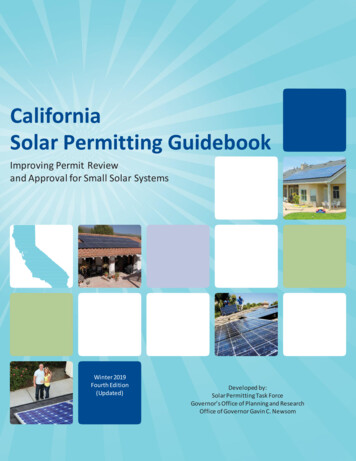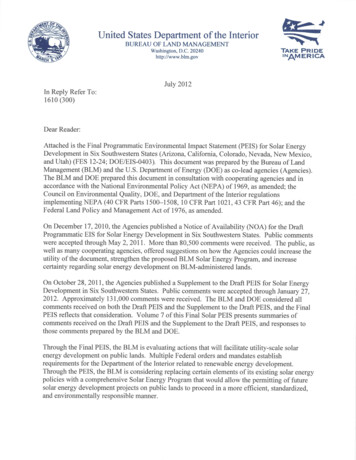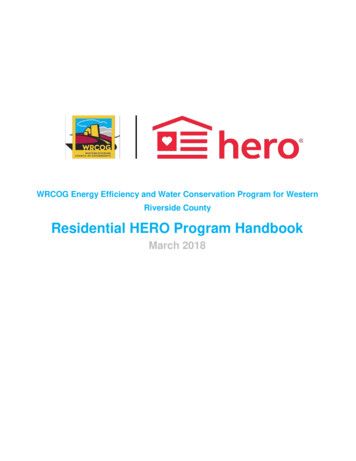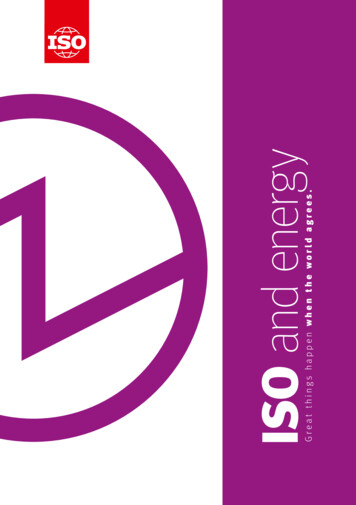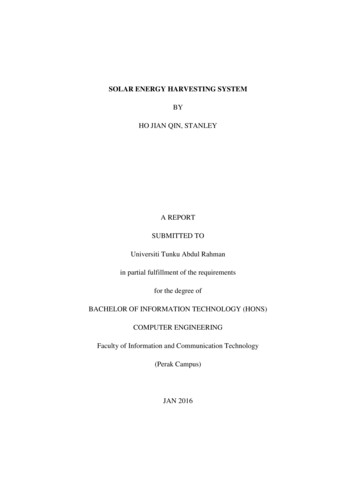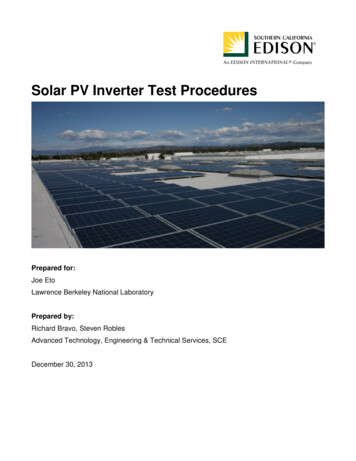
Transcription
CaliforniaSolar PermittingGuidebookImproving Permit Reviewand Approval for Small Solar SystemsSpring 2015Second Edition(Updated)Developed by:Solar Permitting Task ForceGovernor’s Office of Planning and ResearchOffice of Governor Edmund G. Brown Jr.
California Solar Permitting GuidebookImproving Permit Review and Approval for Small Solar SystemsGovernor’s Office of Planning and ResearchOffice of Governor Edmund G. Brown Jr.Project ManagersClaudia Eyzaguirre, Center for Sustainable EnergyJeffrey Mankey, Governor’s Office of Planning and ResearchSarah Smith, Center for Sustainable EnergyCarolyn Angius, Governor’s Office of Planning and ResearchLead ContributorsCalifornia Building Standards CommissionCalifornia Department of Housing and Community DevelopmentCalifornia State Fire MarshalCalifornia Solar Energy Industries Association (CALSEIA)City of Los AngelesMar Structural DesignCenter for Sustainable EnergyPublished spring 2015Second edition (updated)Partial funding from the U.S. Department of Energy, SunShot Initiative
TABLE OF CONTENTSPREFACE .4ACKNOWLEDGMENTS.5PURPOSE AND USE OF THIS GUIDE .6Part1Part2Part3Part4Part5CURRENT LAWS, REGULATIONS AND CODES.8State Code Requirements.8Limits on Local Modifications.8Permit Fees.10THE PROJECT APPROVAL PROCESS.12Permit Application and Plan Review.12Site Inspection.15Local Utility Approval (Solar PV systems only).16RECOMMENDATIONS FOR EXPEDITED PERMITTING FOR SMALL PV SYSTEMS.18PV Toolkit for Local Governments.211) Submittal Requirements Bulletin — Solar Photovoltaic Installations 10 kW or Less.222) Eligibility Checklist for Expedited Solar Photovoltaic Permitting.253) Solar PV Standard Plan — Simplified Central/String Inverter Systems.264) Solar PV Standard Plan — Simplified Microinverter and ACM Systems.395) Structural Criteria for Residential Rooftop Solar Energy Installations.456) MOU Regarding Solar Photovoltaic Plan Review and Inspection Services.557) Inspection Guide for PV Systems.57RECOMMENDATIONS FOR EXPEDITED SOLAR WATER HEATING INSTALLATIONS.65SWH Toolkit for Local Governments.681A) Submittal Requirements Bulletin — Solar Domestic Water HeatingInstallations 30 kWth or Less.691B) Submittal Requirements Bulletin — Solar Pool Heating Installations30 kWth or Less.712A) Eligibility Checklist for Expedited Solar Domestic Water Heating Permitting.732B) Eligibility Checklist for Expedited Solar Pool Heating Permitting.743A) Solar Domestic Water Heating Standard Plan. 753B) Solar Pool Heating Standard Plan.764) Structural Criteria for Residential Rooftop Solar Energy Installations.795A) Inspection Guide for SDWH Systems.895B) Inspection Guide for Solar Pool Heating Systems.92RESOURCES AND INFORMATION . 93Understanding the Code.93Code Requirements for Solar Photovoltaic (PV) Systems.93Code Requirements for PV on Buildings other than One- and Two-Family Dwellings.98Code Requirements for Solar Water Heating (SWH) Systems.106Glossary.109Additional Resources .111
PREFACECalifornia is a world leader in renewable energy generation. Solar and wind power, as well as emergingtechnologies such as biomass and fuel cells, are transforming California. Renewable energy is helping to powerthe state’s economy, reducing our state’s reliance on imported energy sources and decreasing air pollution.California’s state and local governments have set aggressive goals to expand renewable energy. In 2011,California adopted a Renewable Portfolio Standard (RPS) requiring that at least one-third of the state’selectricity come from clean energy sources by 2020. Many local governments also have their own targets forrenewable energy. Additionally, Governor Edmund G. Brown Jr. has set a specific goal of developing 12,000megawatts of small-scale, localized renewable electrical power (often called “distributed generation”) inCalifornia by 2020.Small-scale renewable energy benefits California communities. It increases energy reliability for residents andbusinesses by generating electricity near where it is consumed. This type of energy can also provide stableelectricity prices for consumers and creates thousands of jobs across California.In order to expand small-scale renewable energy across California, Governor Brown instructed the Governor’sOffice of Planning and Research (OPR) to help remove barriers to its development. One such barrier is thepatchwork of permitting requirements for small solar installations throughout the state. Solar energy systemshave been installed in California for decades, and their technology, as well as the methods to install andmaintain them, is well established. As a result, permitting for these small and simple solar projects should be assimple and standardized as possible.The first California Solar Guidebookwas published in 2012, the result ofa collective effort of stakeholdersfrom local government, the buildingindustry, professional associations,solar companies, utility providers andstate regulatory agencies. Many localpermitting agencies adopted practicesand standard documents outlined inthe Guidebook. These practices madeinstalling solar less expensive andincreased expansion of this technologyin California.Despite these improvements, however, costs to permit solar are still higher than necessary. Increasedsolar adoption has inundated many jurisdictions with permit applications and inspection requests. Solartechnologies have changed, new laws have been passed and codes have been revised. This second edition ofthe Guidebook addresses those changes, improves upon the recommended process for expedited permitting ofsolar PV systems, and adds information about solar water heating systems.4California Solar Permitting Guidebook
ACKNOWLEDGMENTSThis Guidebook was developed in collaboration with the following individuals and organizations.Ken Alex, Jeff Mankey, Carolyn Angius, Jake BuffenbargerJennifer AlfsenGeorge AppleMark BaldassariMisha Balmer, Alan Fields, Hilary PearsonBill BrooksLarry BruggerSteve BurgerKelly M. SherfeyEmilio Camacho, Elli HarlandClaudia Cappio, Shawn Huff, Kyle Krause, Richard Weinert, Emily WithersNicholas ChasetVal Anderson, Daniel Chia, Michael Galvez, Hilary Wall, Rick HansonSachu Constantine, Claudia Eyzaguirre, Tamara Gishri, Sarah Smith, Skip FralickJason CrapoWade CrowfootAndy DavidsonBernadette Del ChiaroTom EnslowGary GerberSharon GoeiMark GoodmanPete GuisasolaDaniel HamiltonAlison HealyAndrew Henning, Kevin Reinertson, Mike RichwineTonya HooverDon HughesPeter JacksonMostafa KasheJanice KluthSuzanne Korosec, Sherrill Neidich, Le-Quyen NguyenSheila LeeBrian LeongGreg Magofna and Sarah MooreJeff MathiasTom McCalmontEd MurrayJim McGowan, Michael Nearman, Enrique RodriguezLes NelsonKimberly Martin, Stephanie Nicholas, Vince NicolettiSusan OtoMatthew PaissRhonda ParkhurstVance PhillipsMichael QuirozBob RaymerPatrick RedgateRick RenfroGlenn SchainblattBill StewartJohn TaeckerTheresa TownsendBrandon Treloar, Walker WrightShannan WestScott WetchLarry WilliamsJohn WolfeOsama Younan, Behzad EghtesadyThomas YurystaRobert WoodsEddie BernacchiBrandon CarlsonAdam GerzaShawn MartinPatrick HealyNancy SpringerMartin RedmondBeth MaynardGovernor’s Office of Planning and ResearchSolar NexusCSD SolarLeo Patnode Enphase EnergySungevityBrooks EngineeringInternational Code CouncilCity of FolsomCalifornia Building Officials (CALBO)California Energy CommissionDepartment of Housing and Community DevelopmentCalifornia Public Utility CommissionSolarCityCenter for Sustainable EnergyContra Costa CountyGovernor’s OfficeUniracCALSEIAAdams BroadwellSun Light & PowerCity of Santa ClaraCLEEBureau VeritasABAGCity of San FranciscoCAL FIREState Fire MarshalSanta Clara CountyCity of BakersfieldLos Angeles CountyCity of Chula VistaCalifornia Energy CommissionCity of Santa ClaraCity of FresnoCity of BerkeleySynergy SolarMcCalmont EngineeringAztec SolarBuilding Standards CommissionIAPMOSan Diego CountySacramento Municipal Utility DistrictSan Jose Fire DepartmentCity of Palo AltoCity of San Ramon3rd Wave ConsultingCalifornia Building Industry AssociationAMECO SolarCity of Elk GroveCity of SebastapolSolarCraftUnderwriters LaboratoriesDivision of the State ArchitectSunrunGO BizCarter, Wetch and AssociatesSteel Framing Industry AssociationMar Structural DesignCity of Los AngelesOptonyCity of ConcordNational Electrical Contractors AssociationNew Day SolarSullivan SolarInternational Code CouncilCounty of San DiegoCounty of ButteCity of Palo AltoDepartment of Housing and Community DevelopmentCalifornia Solar Permitting Guidebook5
PURPOSE AND USE OF THIS GUIDEThis Guidebook is designed to help local governments and their permitting agencies improve permitting ofsmall solar energy systems. It is also designed to help building owners and solar installers navigate permittingas efficiently as possible. Practices recommended in this Guidebook apply to permitting agencies of all sizes.The Guidebook is also written for permit applicants with all levels of expertise.The Guidebook is organized into five main sections.Part1CURRENT LAWS, REGULATIONS AND CODES: This section explainscurrent legal requirements for solar installations in California.Part2THE PROJECT APPROVAL PROCESS: This section describes importantaspects of permit review and project inspection.PartRECOMMENDATIONS FOR EXPEDITED LOCAL SOLAR PERMITTING:These sections recommend a streamlined local permitting process for small,simple solar PV and solar water heating installations (including both solardomestic water heating [SDWH] and solar pool heating [SPH]) and providestandard forms that can be used to streamline permitting.3Part4Part5RESOURCES AND INFORMATION: This section provides informationalmaterials that can help local governments clarify current state requirementsfor all solar installations.The Guidebook concludes with a glossary of terms and a list of helpful informationsources for local governments and permit applicants.This Guidebook focuses on the permit review and approval to install a rooftop solar system. It does notaddress zoning, land use approvals or environmental review that may be required for larger solar projects.This Guidebook addresses both solar photovoltaic (PV) and solar water heating (SWH) technologies. Thesetechnologies have many fundamental similarities, as well as several important differences. Where requirementsare discussed that apply to only one of these technologies, the text will note this.In the course of the Guidebook, several types of solar installation are discussed, including systems onresidential and commercial building rooftops, in parking lots and on parking structures and mounted on theground. It is important to note that each installation type has a certain set of installation requirements. Inaddition, rooftop installations have some differing requirements depending on whether they are installed on acommercial or residential building.The toolkit sections of this Guidebook recommend an expedited permitting process for simple PV systems10 kilowatts (kW) or less and a process for SWH systems 30 kilowatts thermal (kWth) or less. An expeditedpermitting process refers to streamlining the permit process for simple, typical solar installations so that6California Solar Permitting Guidebook
permits can be issued in an “over-the-counter” or similar manner. This Guidebook uses the terms expeditedand streamlined synonymously. These thresholds capture approximately 90% of the solar systems that arecurrently being installed. Above this size threshold, a system’s design considerations become more complex.Assembly Bill 2188 (2014, Muratsuchi) requires jurisdictions to adopt an expedited permitting process that“substantially conforms” with that laid out in Parts 3 and 4 of this Guidebook. Jurisdictions may modify thesedocuments as specified and should review these sections of the Guidebook for a more detailed discussion ofthis process.An electronic version of this Guidebook that includes clickable links to Internet resources can be found onthe websites of several California entities: The Governor’s Office of Planning and Research, CaliforniaBuilding Standards Commission, Office of the State Fire Marshal, California Department of Housing andCommunity Development and Center for Sustainable Energy.California Solar Permitting Guidebook7
Part1CURRENT LAWS, REGULATIONS AND CODESState Code RequirementsCalifornia’s state building codes provide uniform requirements for buildings throughout the state. Theserequirements are contained in Title 24 of the California Code of Regulations (CCR). The CCR is divided into28 separate titles based on subject matter or state agency authority. Title 24 is the 24th title within the CCR andis reserved for state regulations that govern the design and constructions of buildings, associated facilities andequipment. These regulations are also known as the state’s “building standards.”Title 24 applies to all building occupancies and related features and equipment throughout the state. It containsrequirements for a building’s structural, mechanical, electrical and plumbing systems, in addition to measuresfor energy conservation, sustainable construction, maintenance, fire and life safety and accessibility. A commonmisunderstanding is that Title 24 relates only to energy conservation or accessibility requirements. In fact,it covers a much wider range of requirements for buildings. Specific areas within Title 24 identify certainrequirements for solar PV installations such as the California Electrical Code, California Building Code,California Plumbing Code, California Mechanical Code and California Residential Code (which applies toresidential buildings of one or two units).State regulations should not be confused with state laws enacted through the legislative process. Stateregulations are adopted by state agencies where necessary to implement, clarify and specify requirements ofstate law. The California Building Standards Commission and the other state adopting agencies review thecodes and update Title 24 as appropriate. Title 24 is updated every 18 months with a model code update everythree years.Several portions of Title 24 govern installation of a solar energy system.California Building Code, Title 24, Part 2California Residential Code, Title 24, Part 2.5 (One- and Two-family dwellings)California Electrical Code, Title 24, Part 3California Mechanical Code, Title 24, Part 4California Plumbing Code, Title 24, Part 5California Energy Code, Title 24, Part 6California Fire Code, Title 24, Part 9The intent of this Guidebook is to provide consistent interpretation of these Title 24 requirements throughoutthe state. This Guidebook is not intended to create, explicitly or implicitly, any new requirements.While current Title 24 requirements establish several legal standards for installation of solar energyinstallations, Title 24 may be amended through the state’s code update process to further clarify requirementsfor solar PV installations or SWH systems. Updated information regarding new code requirements, as well asthe code updating process, is available on the California Building Standards website at www.bsc.ca.gov.Limits on Local ModificationsBuilding CodesCities and counties in California are required by state law to enforce Title 24 building standards. However,cities and counties may adopt local laws (also called “ordinances”) to modify these state building standardsunder limited circumstances because of local climatic, geological or topographical conditions. This limited8California Solar Permitting Guidebook
allowance means that a city or county may have local ordinances that modify or add to the provisions of Title24 for solar systems. The California Building Code (Sections 1.1.8 and 1.1.8.1) outlines the specific findingsthat a city or county must make for each amendment, addition or deletion to the state building codes.Cities, counties and local fire departments file these local amendments to the state building code with theCalifornia Building Standards Commission. Findings that are prepared by fire protection districts mustbe ratified by the local government and are then filed with the California Department of Housing andCommunity Development.PLANNING AND ZONING REQUIREMENTSCalifornia’s cities and counties have authority to adopt laws that govern local land use. Local governmentstypically enforce their own general plans and other comprehensive plans that guide development in theircommunities and then adopt local ordinances and zoning regulations to enforce these plans.Local governments generally can adopt local laws regarding where certain land uses, such as large commercialenergy generation, can be located within their communities. A more detailed conversation regarding land useand zoning for solar projects is addressed in a 2012 guide produced by the California Planning DirectorsAssociation (CPDA), which is referenced in the Resources section of this Guidebook. This guide recommendsseveral steps to streamline land use decisions regarding solar energy.REQUIREMENT TO ADOPT AN EXPEDITED PERMITTING PROCESS FOR SMALL ROOFTOP SOLARAssembly Bill 2188 (Muratsuchi, 2014) requires local governments to adopt an administrative ordinance thatcreates a streamlined permitting process for small rooftop solar system installations on or before September30, 2015. It also limits the number of inspections that may be required.These requirements are applicable to solar energy systems that1.2.3.4.Are no larger than 10 kilowatts alternating current nameplate rating or 30 kilowatts thermalConform to all applicable state fire, structural, electrical and other building codes as adopted oramended by the city, county or city and county and paragraph (3) of subdivision (c) of Section 714of the Civil CodeAre installed on a single-family or duplex family dwellingDo not exceed the maximum legal building height as defined by the authority having jurisdictionThe law also requires that this streamlined process “substantially conform” to the permitting process laid outin this Guidebook. See Parts 3 and 4 of this Guidebook for an explanation of this process.Finally, the law sets limits on the cost and efficiency impacts that homeowner associations may have onproposed solar projects. The full text of this bill can be found here.RESTRICTIONS TO LOCAL LIMITS ON SOLAR ENERGYWhere solar energy is generated for on-site use, state law clearly limits local governments’ ability tounreasonably prohibit solar systems. The following state laws place limits on local regulation of solar energysystems.California Solar Rights ActThe California Solar Rights Act is a state law, passed in 1979, that elevates the timely and cost-effectiveinstallation of solar energy systems as a matter of statewide importance. The law establishes the right ofhomeowners and businesses to access sunlight in order to generate solar energy, limits the ability of localgovernments and homeowner associations (HOAs) to prevent the installation of solar systems and prohibits apublic entity from receiving state funding for solar energy programs if it unreasonably restricts the installationof solar energy systems.Part 1: Current Laws, Regulations and Codes9
The act’s preamble provides the overarching intent of the act by stating:It is the intent of the Legislature that local agencies not adopt ordinances that create unreasonable barriersto the installation of solar energy systems, including, but not limited to, design review for aesthetic purposes,and not unreasonably restrict the ability of homeowners and agricultural and business concerns to installsolar energy systems. It is the policy of the state to promote and encourage the use of solar energy systems andto limit obstacles to their use. It is the intent of the Legislature that local agencies comply not only with thelanguage of this section, but also the legislative intent to encourage the installation of solar energy systems byremoving obstacles to, and minimizing costs of, permitting for such systems.The Solar Rights Act also requires that local governments use an administrative, nondiscretionary reviewprocess for on-site solar energy systems. As indicated above, no restrictions related to visual or aestheticconcerns are permitted. Section 65850.5 (c) of the act also prohibits local governments from denying a usepermit for a solar energy system “. . . unless it makes written findings based upon substantial evidence in therecord that the proposed installation would have a specific, adverse impact upon the public health or safety,and there is no feasible method to satisfactorily mitigate or avoid the specific, adverse impact. The findingsshall include the basis for the rejection of potential feasible alternatives of preventing the adverse impact.”Specific requirements of the Solar Rights Act have been refined through a series of court cases in recentdecades. For a more detailed understanding of specific legal requirements of this act, please consult a reportcompleted by the Energy Policy Initiatives Center at the University of San Diego School of Law, which isdetailed in the Resources section at the end of this Guidebook.Requirements of the Solar Rights Act are contained in the following sections of California law: California CivilCode, Sections 714 and 714.1; California Civil Code, Sections 801 and 801.5; California Government Code,Section 65850.5; California Health and Safety Code Section 17959.1; California Government Code, Sections66473.1 and 66475.3.California’s Solar Shade Control ActCalifornia’s Solar Shade Control Act, enacted in 1978, is a state law intended to protect solar systems frombeing shaded from sunlight by neighboring trees or buildings. A 2008 amendment of this act limits theapplication of this law to situations in which a neighbor receives a notice that a solar energy system will beinstalled that they might shade if they plant trees or remodel their building.Requirements of the act are contained in California Public Resources Code, Sections 25980 through 25986.CEQA Exemption for Certain Solar InstallationsSenate Bill 226, passed in 2011, is a state law establishing that certain solar energy systems are exempt fromenvironmental review under the California Environmental Quality Act (CEQA). To qualify under thisstatutory exemption, a solar energy project must be located either on the roof of an existing building or on anexisting parking lot. SB 226 makes clear the legislative intent that rooftop and parking lot solar projects do notrequire in-depth environmental review.This CEQA exemption is contained in Section 21080.35 of the Public Resources Code.Permit FeesCurrent state law requires that fees charged by a local enforcing agency for permit processing and inspectioncannot exceed the reasonable cost of providing the service for which the fee is charged. In other words, feerevenue must only be used to defray the cost of permit processing and enforcement and cannot be used10California Solar Permitting Guidebook
for general revenue purposes. These requirements are contained in Government Code Section 65850.55,Government Code Section 66016 and State Health and Safety Code Section 17951.Government Code Section 66015 further sets specific limits on the amount local enforcing agencies can chargefor solar PV permit fees. Fees in excess of these limits must be explicitly justified and are prohibited unless themunicipality determines that it has already adopted a streamlined permit approval process.Permit Fee Limits for PVResidentialCommercial15 kW or less 50050 kW or less 1000More than 15 kW 500 15 per kWabove 1550 kW – 250 kW 1000 7 per kWabove 50 kWMore than 250 kW 2400 5 per kWabove 250 kWWhile some local governments have yet to comply with these laws, other local governments have reduced oreven waived fees to install solar systems, recognizing the many benefits created by expansion of solar energy intheir communities.There is no state requirement for permit fees for solar water heating systems. However, a clear fee scheduleshould be provided that considers shorter counter time for issuing streamlined permits.Part 1: Current Laws, Regulations and Codes11
Part2THE PROJECT APPROVAL PROCESSSecuring approval for a solar energy project involves several basic steps. First, a permit application is submittedto a local permitting agency, known within government as the “enforcing agency” and reviewed by that agency.Typically, a permit is submitted on behalf of a building owner by the contractor installing the solar energysystem. Once the permit application is approved, the applicant has permission to build the solar installation.After the solar installation is constructed, it is inspected by the enforcing agency to ensure it complies withapplicable building codes and local ordinances. Each of these steps is described in more detail below.STEPS FOR PERMIT REVIEW AND APPROVALLocal Enforcing Agency ReviewSubmit permitapplicationand materialsPermit reviewand approvalConstructionof solar PVsystemSite inspectionand finalapprovalLocal Utility ApprovalSubmit request to “interconnect”the solar installation to thelocal electricity gridSite inspection andinterconnection approvalFor solar PV installations, during the local agency project approval process the permit applicant should alsocontact the local utility provider to request permission to connect the solar installation to the local distributiongrid. The solar PV system cannot be “turned on” until approval is granted by both the local agency and thelocal utility. Solar water heating systems do not require utility approval unless a grid-connected PV system isincluded (hybrid systems have both grid-connected PV and thermal energy collection).Well-informed solar installers and knowledgeable, well-trained local agency staff are critical to achieve anefficient permit approval process. Please consult the Resources section of this Guidebook for information ontraining available to both solar contractors and agency staff. Effective training is one of the most importantsteps that local governments and the solar industry can take to ensure efficient permitting.Permit Application and Plan ReviewThis section explains the permit review process for solar energy installations and common issues that must beaddressed to minimize unexpected delays in the permit review process.Enforcing Agency ReviewThe first step to build a solar installation requires applying for a permit to construct the installation fromthe local enforcing agency, which is most often the local building department. Each local enforcing agency isorganized slightly differently, but all have an established process for receiving, reviewing and approving permits.12California Solar Permitting Guidebook
The local agency enforces all Title 24 requirements from the state as well as any local requirements on solarenergy installations. In many cases, the local agency must interpret how state requirements apply to certainbuildings. The enforcing agency must verify that the installation complies with structural requirements. Forsolar PV installations, the enforcing agency must verify that it meets electrical requirements and applicablefire safety ratings, and for SWH installations, the enforcing agency must verify that it meets plumbing andmechanical requirements. Each of these areas is discussed in detail.Structural RequirementsInstallation of a solar energy system on the roof of a structure adds weight to the structure, commonly referredto as “dead load.” This additional weight must be accounted for to ensure that the building can safely bear theweight of the solar installation. In new construction, this additional load is usually addressed easily and at verylittle cost. Where a solar system is added to existing buildings, the cost and complexity of
As a result, permitting for these small and simple solar projects should be as simple and standardized as possible. The first California Solar Guidebook was published in 2012, the result of a collective e
